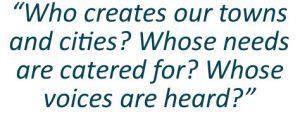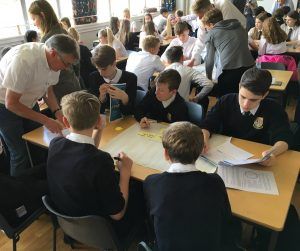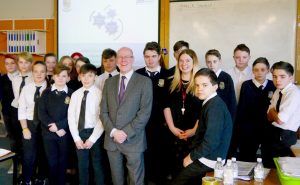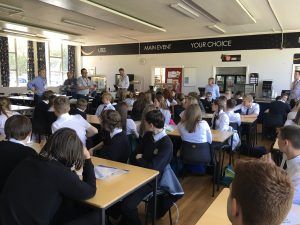This issue, our contributors have shown that the path to achieving inclusive community engagement is far from easy. This is often true when attempting to involve different age groups. In light of this, Petra Biberbach, Chief Executive at PAS, highlights the value and the success that can be achieved by engaging with young people for the future of our places, as demonstrated by PAS’ current project in Galashiels.
What makes a great place? This is a question that our organisation and its network of 420 volunteers grapple with every day. As a third sector organisation, our planners, urban designers and architects don’t just help communities to navigate their way through regulations and procedures; they also help people to become involved with the questions of how we create and manage our places and importantly, actively promote the inclusion of all.
Who creates our towns and cities? Whose needs are catered for? Whose voices are heard? This question of ‘who’ is a thread that runs through all of our work, and is the reason why we talk about ordinary citizens as ‘placemakers’. To a greater or lesser extent, we all influence our built environment. We are all placemakers.
 How does our built environment look when viewed through the lens of young people? Take a young person of school age. They will live with the consequences of the decisions made today for the longest time. But are they involved in making those decisions?
How does our built environment look when viewed through the lens of young people? Take a young person of school age. They will live with the consequences of the decisions made today for the longest time. But are they involved in making those decisions?
Theirs is a collection of voices that are seldom-heard in the decision-making process. Indeed, the former Commissioner for Children and Young People, Tam Baillie, said that we have a “blind spot” when it comes to young people’s participation in placemaking.
Why should we include young people in placemaking?
Arguably, the lack of inclusion of young people has a negative impact on society as a whole. If young people – one of the groups suffering most from of the shortage in (affordable) housing – participated in all key decisions about new housing, things might be different.

Using the Place Standard Tool, PAS is working with pupils at Galashiels Academy.
The UN Convention on the Rights of the Child, which the UK ratified in 1991, is a legally-binding international agreement setting out the civil, political, economic, social and cultural rights of every child, regardless of their race, religion or abilities. In the context of placemaking, Article 12 of the Convention is crucial: the views of children and young people must be considered and taken into account in all matters affecting them. But are they?
From our experience, young people lack influence in their environment in three ways:
- How they experience their place on a day to day basis;
- Under-representation in decisions about the future of their place;
- Relative isolation from older generations, particularly in the civic forum.
How can we involve young people successfully?
So how can we bridge these gaps? One example is a project we are piloting with Galashiels Academy. This is a partnership that will run over several years, working with three year groups. This project does two things.
Firstly, it takes advantage of digital technology, partly developed with the students themselves, to make it easier for young people (and people of any age) to share their views on their place – what works, what doesn’t work and what could change. Digital technology has revolutionised many aspects of our lives but has so far had relatively little impact on planning.

Kevin Stewart MSP, Minister for Local Government & Housing, with pupils at Galashiels Academy involved in Bridging the Gaps project.
Secondly, different generations are often set at odds against other and there is often little public space to exchange views. This is something we are changing with this new partnership project – and is indeed the reason why it is called ‘Bridging the Gaps‘. Students from Galashiels Academy are working with our organisation, but more importantly, they are working with local community partners – community organisations, the local authority and regeneration partners.
All of this is to enable a meaningful learning exchange between younger and older groups in the town. The young people will work with older residents to share knowledge and skills in digital technology and encourage older members of the community to engage more interactively with the decisions in their built environment.

PAS working with pupils at Galashiels Academy.
In exchange, the young people have an opportunity to learn about civic decision-making process, as well as learn from older local residents how their place has changed over time. This provides young people with an important connection to the past, as well as an awareness that places can and will always change over time.
While this project would be of great value in and of itself, the crucial component is that it is coinciding with a new era of change in the town – with the reopening of the Borders Railway and forthcoming investment in regenerating parts of the town. The town’s youngest residents will be able to influence the future of their place, and generate a civic discussion with other generations about what that future could be.

A Real Opportunity for Change
The Children Rights and Well-being Impact Assessment (CRWIA) applies to all public bodies (and organisations receiving public funds) and came into force in April 2017. The first impact assessments are due to be published in 2020, detailing explicitly how young people are involved in civic processes. Let’s embrace this as a real opportunity for change, to bridge the gaps in engagement and help us all be placemakers.
To find out more about ‘bridging the gaps’ and placemaking from an intergenerational perspective, watch PAS Chief Executive Petra Biberbach’s recent TEDx talk at Queen Margaret University. Watch the video here: http://tiny.cc/BridgingTheGaps
